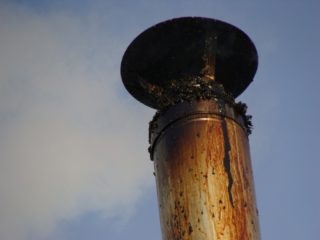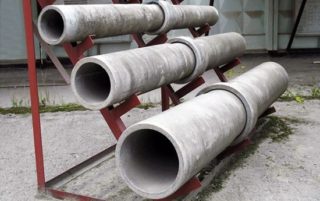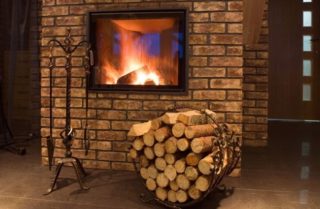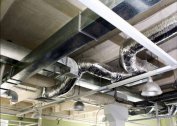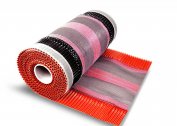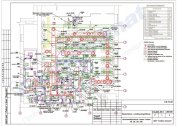The vast majority of private houses, cottages, baths and garages are equipped with autonomous heating. To heat the coolants are used boilers running on gas, solid and liquid fuels. During its combustion, in addition to heat, toxic volatile substances are released, which need to be removed to a height that is safe for people and buildings. During this process, a rather unpleasant phenomenon arises in all respects - condensation in the chimney. The water in the pipe itself does not bode well. The main harm to the design is soot and soot, which, when mixed with liquid, forms active and aggressive compounds that form a hard and oily coating.
Definition of condensate
Moisture is present in hydrocarbons, wood and coal. When heated, it evaporates and, together with smoke, leaves the furnace. Upon contact with the walls of the pipe, the steam cools, passes into a liquid state and is retained on the walls in the form of water droplets. Condensate forms in the chimney when its temperature is below the dew point, which is 45-60 degrees for the combustion products of various fuels.
Condensate is water that forms in a different volume in the outlet channel under the influence of low temperature. The process begins with the misting of the material, then droplets are formed, partially flowing down, and partially absorbing solid particles and toxic gases. The result of this phenomenon is always negative - the formation of growths, consisting of a dense and combustible substance.
Chimney design requirements
Requirements for the design of household chimneys for solid fuel and gas boilers are set out in SNiP 41-01-2003:
- the total height of the pipe from the furnace to the upper cut of the pipe is more than 5 m;
- the rise of the chimney above the roof - at least 100 cm;
- elevation above the ridge - 50 cm;
- the length of the horizontal section is not more than 100 cm;
- the number of angles per channel - up to 2;
- compensation of horizontal sections - the same increase in height.
By design, the chimney can be central, leaving vertically from the room through the floor slabs, and wall, when the pipe is led out immediately from the boiler or at a slight elevation from the pipe.
Consequences of condensation
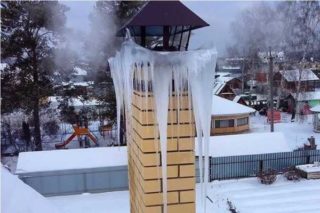
The formation of steam and water droplets on the inner walls of the vent pipe is a problem that cannot be ignored.
If condensate runs through the chimney pipe, it can provoke such dangerous consequences:
- In winter, there is a gradual freezing and thickening of the ice layer. First, the draft decreases, then the channel is completely blocked.
- The substance accumulating in the pipes is flammable and explosive. Condensation in the chimney of a wood stove can cause an explosion and fire.
- When water and combustion products are combined, sulfuric and hydrochloric acids are formed. They corrode ferrous metal and stainless steel.
- Flowing condensate in a direct-flow type sandwich chimney can extinguish the fire and cause a malfunction of the parts of the heating device.
- If the outlet pipe is laid out of brick, moisture absorbed into its walls leads to cracks during freezing, thinning of the walls and rapid collapse of the structure.
The problem is easier to prevent than to eliminate if you know the prerequisites for its occurrence.
Reasons for the appearance
Steam is contained in the combustion products of all fuels. Upon contact with a cold surface, it becomes saturated and turns into water.
The causes of condensation in the drainage channels are as follows:
- Excessive sandwich pipe height when the tip barely heats up.
- Lack of thermal insulation in the chimney of a gas boiler.
- Use of raw firewood in a solid fuel boiler.
- Low exhaust gas temperature. This is typical for modern double-circuit boilers.
- An incorrectly planned channel shape, when there are many knees and horizontal sections along its length. Traction decreases, temperature drops.
- The roughness of the walls. They slow down the speed of the exhaust gases, which leads to cooling of the pipe and the formation of droplets.
- Lack of access to the blower of the required volume of fresh air - a furnace defect or improperly planned ventilation system.
If a condensation problem is discovered, it is necessary to deal with it by all available means, without putting it off the bat.
Remedies
It is difficult but possible to prevent condensation from occurring without affecting the efficiency of the furnace. The following options are used:
- Maintenance of the circuit of installation. Sometimes it is advisable to spend money on expensive materials for the chimney and its laying in a direct way through the floors. Subsequently, this will affect the efficiency of operation of the heating system.
- Warming. The best solution is to use stone wool and an outer sleeve embedded on top.
- Use of fuel containing a minimum percentage of moisture. Such is natural gas and factory briquettes.
- Preliminary drying of fuel. It can simply be stored in a warm and dry room or pre-laid on hot surfaces.
- Chimney cleaning. The smoother its inner surface and the wider the clearance, the better the draft and the higher the temperature of the gases. And that means less condensation and deposits. There are chemical, thermal and mechanical cleaning methods.
- Use of a steam trap. This is a vessel that is installed in the lower part of the vertical channel, below the outlet of the pipe or horizontal outlet. The tank is equipped with access for draining the liquid.
To ensure the removal of condensate from the chimney for a gas boiler and solid fuel analogue is easy if you take the necessary measures constantly and systematically.
Condensation Prevention
To eliminate the appearance of moisture in the pipe from the boiler, you should follow a few simple rules:
- Properly design and properly assemble the branch structure.
- Use high-quality materials and modern technology in construction.
- Use well-dried and tested fuels from reliable suppliers.
- Timely diagnose and clean the pipe from soot.
- Install a nozzle at the end of the chimney that increases traction and eliminates the dew point - a deflector.
All this will simplify and protect the operation of the boiler, extend the life of the heating system.
